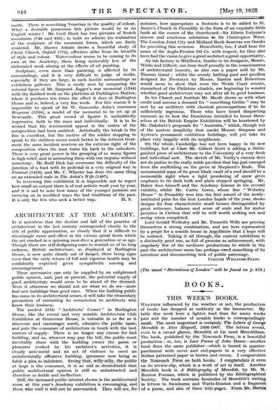ARCHITECTURE AT THE ACADEMY.
IT is notorious that the decline and fall of the practice of architecture in the last century corresponded closely to the ebb of public appreciation, so closely that it is difficult to disentangle cause and effect in the vicious spiral down which the art crashed in a spinning nose-dive a generation or so ago. Though there are still disfiguring scars to remind us of its long sickness, British architecture, as displayed at Burlington House, is now quite clearly out of danger, there being signs even that the early return of full and-vigorous health may be confidently expected given sympathetic nursing and encouragement.
These necessaries can only be supplied by an enlightened public opinion, and, just at present, the potential supply of good architecture would seem to be ahead of the demand. Were it otherwise we should not see what we do see—more bad new buildings than good ones. When the building public has come to its architectural senses, it will take the elementary precaution of entrusting its commission to architects who know their business.
The modest little " Architects' Corner " in Burlington House, like the recent and very notable Architecture Club Exhibition at Grosvenor House, is valuable in so far as it discovers and , encourages merit, educates the public taste, and puts the consumer of architecture in touch with the best sources of supply. There is no longer any excuse for bad building, and as, whoever may pay the bill, the public must inevitably share with the building owner the pains or pleasures evoked by his architect's activities, it is clearly anti-social and an act of violence to erect an architecturally offensive building, ignorance now being as futile a plea as indolence. Seeing that, willy-nilly, the public at large is the consumer, it is as odd as discreditable that public architectural opinion is still so uninstructed and therefore so feeble and ineffective.
Still, the increased public interest shown in the architectural room at this year's Academy exhibition is encouraging, and those_ who visit it will not be unrewarded. They will see, for instance, how appropriate a footnote is to be added to St. James's Church in Piccadilly in the form. of an exquisite little bank at the corner of the churchyard—Sir Edwin Lutyens's sincere and courteous salutation to Sir Christopher Wren. The London Joint City and Midland Bank deserves our thanks for providing this occasion. Henceforth, too, -I shall hear the name of the Anglo-Persian Oil Co. with respect, for they also have had the vision to give a great architect a great opportunity.
An ink factory in Middlesex, thanks to its designers, Messrs. Wallis and Gilbert, can bear itself proudly in the consciousness of architectural honesty, as also can a paper mill by Mr. Thomas Grant ; whilst the seemly bathing pool and pavilion designed for Prestatyn by Messrs. Easton and Robertson would seem to show that even the Welsh Coast resorts, staunchest of the Philistine citadels, are beginning to wonder whether good architecture may not after all be good business.
In his Church and Institute Mr. Maufe shows us with what credit and success a demand for " something Gothic " may be met by an architect with classical preoccupations if he be sufficiently ingenious. Those who have heard disquieting rumours as to how the Dominions intended to house them- selves at the British Empire Exhibition will be heartened by Mr. Oakshott's proposals for " Australia," which, though not of the austere simplicity that marks Messrs. Simpson and Ayrton's permanent exhibition buildings, will yet take its place very happily with its neighbours.
On the whole, Cambridge has not been happy in its new buildings, but at Clare Mr. Gilbert Scott is adding a distin- guished piece of architecture to the University of a very fresh and individual sort. The sketch of Mr. Verity's cinema does not do justice to the really noble pavilion that has just emerged from the scaffolding on the green at Shepherd's Bush. The monumental mass of its great black vault of a roof should• be a memorable sight when a light powdering of snow gives emphasis to its dark bulk and plain stepped' springing. Mr. Baker does himself and the Academy honour in his several exhibits, whilst Mr. Curtis Green, whose fine " Wolseley House " in Piccadilly won him the first award of the newly- instituted prize for the best London facade of the year, shows designs for four characteristic small houses distinguished by great reticence, balance and sense of scale and for motor premises in Chelsea that will be well worth seeking out and seeing when completed.
Lord Gerald Wellesley and Mr. Trenwith Wills are proving themselves a strong combination, and are here represented by a projet for a seaside house in Argyllshire that I hope will be realized. Taking it all through, the current exhibition is a distinctly good one, as full of promise as achievement, with singularly few of the mediocre productions to which in the past the architecture room has perhaps owed something of its notorious and disconcerting lack of public patronage.
CLOUGH WILLIAMS-ELLIS.










































 Previous page
Previous page